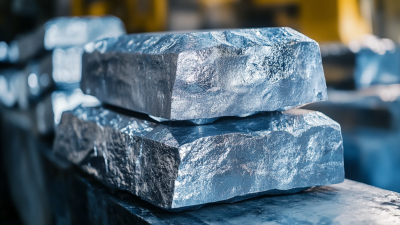Leave Your Message
In the rapidly evolving landscape of sustainable technology, Silicon Metal Producers play a pivotal role in driving innovation and addressing environmental challenges. As global demand for silicon-based materials continues to surge—expected to reach a market value of $22.2 billion by 2027, according to a recent report by Grand View Research—the industry's focus on sustainable practices has become increasingly critical. These producers are not only at the forefront of developing high-purity silicon used in solar panels and electric vehicles but are also confronting significant issues related to resource extraction, energy consumption, and waste management. As they navigate these challenges, Silicon Metal Producers are redefining their operational strategies, prioritizing eco-efficiency, and spearheading initiatives that align with a circular economy. This blog will explore how these key players are shaping the future of sustainable innovation while tackling the pressing problems associated with their industry.

Silicon metal plays a critical role in the development of sustainable technologies, serving as a fundamental component in various green applications. According to a report by Roskill, the demand for silicon metal is projected to reach 3.7 million tons by 2025, driven by its applications in renewable energy and electric vehicles. This growth is largely attributed to the increasing need for efficient photovoltaic cells, where silicon is essential for converting sunlight into electricity. With over 90% of solar panels utilizing silicon-based materials, its importance in advancing clean energy solutions cannot be overstated.

Furthermore, the electric vehicle (EV) market is accelerating the need for silicon metal, particularly in battery technology. Market analysts predict that the demand for silicon anodes in lithium-ion batteries could dominate the market by 2030, contributing to increased energy density and longer battery life. Recent studies estimate that replacing just 10% of graphite in batteries with silicon could improve efficiency by 30%, a significant leap towards enhancing EV performance. As companies continue to innovate in material science, silicon metal stands at the forefront, catalyzing a sustainable technological evolution that supports global decarbonization efforts.
As the world grapples with the dual challenges of climate change and resource depletion, silicon metal producers are taking significant strides toward sustainable practices in their operations. By implementing innovative technologies, these companies are not only enhancing production efficiency but also minimizing their environmental footprint. One notable advancement is the transition to renewable energy sources for powering smelting processes, which drastically reduces greenhouse gas emissions associated with traditional fossil fuels. Furthermore, many producers are adopting circular economy principles, focusing on recycling and repurposing materials, thereby decreasing waste and conserving valuable resources.
In addition to energy improvements, various silicon production facilities are investing in cutting-edge carbon capture technologies. These technologies enable the capture and reuse of CO2 generated during manufacturing, substantially mitigating emissions and contributing to a more sustainable industrial ecosystem. Water management has also become a priority, with producers developing systems to recycle process water, thereby preserving local water bodies and reducing overall consumption. Through these innovative practices, silicon metal producers are not only shaping a sustainable future but also setting an example for other industries to follow in the pursuit of environmental stewardship.
In the realm of sustainable innovation, leading silicon metal producers are taking bold steps to reshape their operations and reduce environmental impact. For instance, companies like Wacker Chemie AG have committed to achieving carbon neutrality by 2030, utilizing advanced technologies such as carbon capture and storage to minimize emissions. According to a recent report by the International Energy Agency, the silicon metal industry is responsible for approximately 1.7% of global industrial carbon dioxide emissions. By implementing greener production techniques, these companies not only aim to lower their carbon footprint but also enhance their market competitiveness in an era increasingly defined by environmental consciousness.
Moreover, firms such as REC Silicon are pioneering renewable energy integration into their manufacturing processes, with plans to utilize solar and wind energy to power operations. A study by MarketsandMarkets projected that the silicon metal market is anticipated to reach USD 10.68 billion by 2025, driven partly by the growing demand for silicon in renewable energy applications. As these leading producers invest in sustainability, they are not only addressing regulatory pressures but also tapping into the lucrative green technology segment, thereby positioning themselves as leaders in both innovation and environmental stewardship.
As the global push for renewable energy intensifies, silicon metal producers are increasingly recognized for their critical role in shaping green energy solutions. In 2022, the International Energy Agency (IEA) reported that solar energy capacity reached 1,185 GW, a staggering increase fueled by the rise of high-purity silicon used in photovoltaic cells. This sharp growth underscores the urgency for sustainable practices within the silicon metal industry, which is essential for meeting future energy demands while mitigating environmental impacts.

Moreover, a market analysis by Research and Markets highlights that the global silicon metal market is expected to grow from approximately $5.61 billion in 2021 to $8.19 billion by 2026, reflecting a compound annual growth rate (CAGR) of 7.9%. This expansion is largely driven by the increasing demand for silicon-based technologies in renewable energy applications. Additionally, innovations in recycling processes have emerged, with companies now achieving up to 90% recovery rates for silicon metal, thereby reducing waste and conserving natural resources. As these trends suggest, silicon metal is not only integral to the advancement of green technologies but is also paving the way for a more sustainable industrial future.
The pursuit of sustainable innovation in silicon metal production is increasingly reliant on strategic collaboration and partnerships. As industries evolve, stakeholders are recognizing that no single entity can tackle the complexities of sustainability challenges alone. By fostering relationships across sectors, such as technology and renewable energy, silicon producers are positioning themselves as leaders in the green transition. For instance, the recent partnership between organizations in the semiconductor ecosystem emphasizes the importance of shared knowledge and resources to drive advancements in sustainable practices.
Moreover, initiatives like the one announced by GLOBSEC with Silicon Castles highlight how strategic alliances can foster innovation in emerging markets. By bringing together expertise and investment, these partnerships are paving the way for sustainable technological solutions that can address pressing environmental issues. As companies recognize the potential for collaboration, they are not only enhancing their sustainable practices but also contributing to a greater collective impact on global sustainability goals. Through these cooperative efforts, the silicon industry is shaping a more sustainable future, demonstrating that partnerships are key to advancing innovative solutions.






